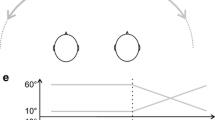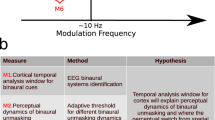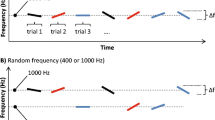Summary
Neuronal response properties such as phasic vs. tonic, onset vs. offset, monotonicity vs. non-monotonicity, and E/E vs. E/I, can be shown to act synergistically suggesting underlying mechanisms for selectivity to binaural intensity correlates of auditory sound source motion. Both identical (diotic), and oppositely directed dichotic AM ramps were used as stimuli in the lightly anesthetized cat, simulating motion in four canonical directions in 3-dimensional space. Motion in either azimuthal direction evokes selective activity in cells which respond best to the onset of monaural sound in one ear and show a decreased response to binaural stimulation (E/I or I/E). In some cells specificity is increased by “off” components in the non-dominant ear. Although these cells fire only at the onset of stationary sound, they fire throughout oppositely directed AM ramps. Motion toward or away from the head evokes responses from EE cells; strong binaural facilitation increases selectivity for motion in depth. The sharpness of direction of tuning was related to the degree of binaural facilitation in E/E cells. Selectivity for sound moving away from the head is correlated with “off” responses, while “on” responses correlate with preference for motion toward the head. Most units showed a monotonic rate function as AM ramp excursion and rate was increased. One third were selective for slower rates of intensity change and may therefore encode slower rates of stimulus motion, as well as direction of movement. The findings suggest that neural processing of auditory motion involves neural mechanisms distinct from those involved in processing stationary sound location and that these mechanisms arise from interactions between the more traditionally studied response properties of auditory cortex neurons.
Similar content being viewed by others
References
Beverley KI, Regan D (1973) Evidence for the existence of neural mechanisms selectively sensitive to the direction of movement in space. J Physiol 235:17–29
Brugge JF, Imig TJ (1978) Some relationship binaural response patterns of single neurons to cortical columns and interhemispheric connections of auditory area AI of cat cerebral cortex. In: Naunton RF, Fernandez C (eds) Evoked electrical activity in the auditory nervous system. Academic Press, New York, pp 487–503
Cynader M, Chernenko G (1976) Abolition of directional selectivity in the visual cortex of the cat. Science 193:504–505
Cynader M, Reagen D (1978) Neurons in cat parastriate cortex sensitive to the direction of motion in three-dimensional space. J Physiol 274:549–569
Eisenman LM (1974) Neural encoding of sound location: a electrophysiological study in the auditory cortex of the cat using free field stimulation. Brain Res 75:203–214
Evans E (1968) Cortical representation. In: DeReuck AVS, Knight J (eds) CIBA Symposium, hearing mechanism in vertebrates. Churchill, London, pp 272–287
Fuzessary ZM, Pollack GD (1985) Determinants of sound location selectivity in bat inferior colliculus: a combined dichotic and free-field stimulation study. J Neurophysiol 54:757–781
Hafter ER, Buell TN, Richards VM (1988) Onset-coding in lateralization: its form, site and function. In: Edelman GM, Gall WE, Cowan WM (eds) Auditory function. Wiley, New York, pp 647–676
Henning, GB (1974) Detectability of interaural delay in high frequency complex waveforms. J Acoust Soc Am 55:84–90
Jenkins WM, Masterton RB (1982) Sound localization: effects of unilateral lesions in central auditory system. J Neurophysiol 47:987–101
Jenkins WM, Merzenich MM (1984) Role of cat primary auditory cortex for sound localization behavior. J Neurophysiol 52:819–84
Kitzes LM, Wrege KS, Cassady J (1980) Patterns of responses of cortical cells to binaural stimulation. J Comp Neurol 192:455–472
Martin RL, Webster WB (1989) Interaural sound pressure differences associated with sound-source location in the frontal hemifield of the domestic cat. Hear Res 38:289–302
Mendelson JR, Cynader MS (1983) Frequency disparity selectivity in cat primary auditory cortex (AI). Soc Neurosci Abstr V9:955
Middlebrooks JC, Knudsen EI (1984) A neural code for auditory space in the cat's superior colliculus J Neurosci 4:2621–2634
Middlebrooks JC, Pettigrew JD (1981) Functional classes of neurons in primary auditory cortex of the cat distinguished by sensitivity to sound source location. J Neurosci 1:107–120
Moore DR, Hutchings ME, Addison PD, Semple MN, Aitkin LM (1984) Properties of spatial receptive field in the central nucleus of the cat inferior colliculus. II. Stimulus intensity effects Hear Res 13:175–188
Pasternak T, Schumer RA, Gizzi MS, Movshon JA (1985) Abolition of cortical directional selectivity impairs visual behavior in cats. Exp Brain Res 61:214–217
Pasternak T, Leinen LJ (1986) Pattern and motion vision in cats with selective loss of cortical directional selectivity. J Neurosci 6:938–945
Phillips DP (1988) Effect of tone-pulse rise time on rate-level functions of cat auditory cortex neurons: excitatory and inhibitory processes of shaping responses to tone onset. J Neurophysiol 59:1524–1539
Phillips DP, Irvine DRF (1981) Responses of single neurons in physiologically defined primary auditory cortex (AI) of the cat: frequency tuning and responses to intensity. J Neurophysiol 45:48–58
Phillips DP, Brugge JF (1985) Progress in neurophysiology of sound localization. Ann Rev Psychol 36:245–274
Regan D, Beverley KI, Cynader M (1979) Stereoscopic subsystem for position in depth and for motion in depth. Proc R Soc B (London) 204:485–501
Richards W, Regan D (1973) A stereo field map with implications for disparity processing. Investig Ophthamol 12:904–909
Semple MN, Aitkin LM, Calford MB, Pettigrew JD, Phillips D (1983) Spatial receptive fields in the cat inferior colliculus Hear Res 10:203–215
Sovijarvi ARA, Hyvarinen (1974) Auditory cortical neurons in the cat sensitive to direction of sound source movement Brain Res 73:455–471
Stumpf E, Toronchuk JM, Cynader MS (1992) Neurons in cat primary auditory cortex sensitive to correlates of auditory motion in three-dimensional space. Exp Brain Res 88:158–168
Wenstrup J, Ross L, Pollack GD (1986) Binaural responses organized within a frequency band representation of the inferior colliculus: implications for sound localization. J Neurosci 6:962–973
Yin TCT, Kuwada S (1983) Binaural interaction in low-frequency neurons in inferior colliculus of the cat II. Effects of changing rate and direction of interaural phase. J Neurophysiol 50:1000–1019
Yost WA, Hafter ER (1987) Lateralization. In: Yost WA, Gourewitch G (eds) Directional hearing. Springer, Berlin, pp 49–84
Zakarauskas P, Cynader MS (1991) Aural intensity for a moving source. Hearing Res 52:233–244
Author information
Authors and Affiliations
Additional information
This research was supported by MRC of Canada grant no MA-9856 to M.S.C., and a MRC studentship to E.S.
Rights and permissions
About this article
Cite this article
Toronchuk, J.M., Stumpf, E. & Cynader, M.S. Auditory cortex neurons sensitive to correlates of auditory motion: underlying mechanisms. Exp Brain Res 88, 169–180 (1992). https://doi.org/10.1007/BF02259138
Received:
Accepted:
Issue Date:
DOI: https://doi.org/10.1007/BF02259138




